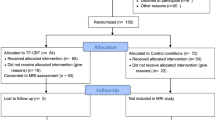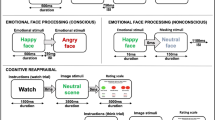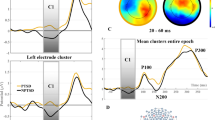Abstract
Thirty to fifty percent of posttraumatic stress disorder (PTSD) patients do not respond to treatment. Understanding the neural mechanisms underlying treatment response could contribute to improve response rates. PTSD is often associated with decreased inhibition of fear responses in a safe environment. Importantly, the mechanism of effective treatment (psychotherapy) relies on inhibition and so-called contextual cue processing. Therefore, we investigate inhibition and contextual cue processing in the context of treatment. Forty-one male war veterans with PTSD and 22 healthy male war veterans (combat controls) were scanned twice with a 6- to 8-month interval, in which PTSD patients received treatment (psychotherapy). We distinguished treatment responders from nonresponders on the base of percentage symptom decrease. Inhibition and contextual cue processing were assessed with the stop-signal anticipation task. Behavioral and functional MRI measures were compared between PTSD patients and combat controls, and between responders and nonresponders using repeated measures analyses. PTSD patients showed behavioral and neural deficits in inhibition and contextual cue processing at both time points compared with combat controls. These deficits were unaffected by treatment; therefore, they likely represent vulnerability factors or scar aspects of PTSD. Second, responders showed increased pretreatment activation of the left inferior parietal lobe (IPL) during contextual cue processing compared with nonresponders. Moreover, left IPL activation predicted percentage symptom improvement. The IPL has an important role in contextual cue processing, and may therefore facilitate the effect of psychotherapy. Hence, increased left IPL activation may represent a potential predictive biomarker for PTSD treatment response.
Similar content being viewed by others
Log in or create a free account to read this content
Gain free access to this article, as well as selected content from this journal and more on nature.com
or
References
APA (2013) Diagnostic and Statistical Manual of Mental Disorders (DSM-5). American Psychiatric Association: Washington, DC.
Aupperle RL, Allard CB, Simmons AN, Flagan T, Thorp SR, Norman SB et al (2013). Neural responses during emotional processing before and after cognitive trauma therapy for battered women. Psychiatry Res 214: 48–55.
Blake D, Weathers F, Nagy L, Kaloupek D, Klauminzer G, Charney DA (1990). Clinican rating scale for assessing current and lifetime PTSD: The CAPS-1. Behav Ther 13: 187–188.
Bradley R, Greene J, Russ E, Dutra L, Westen D (2005). A multidimensional meta-analysis of psychotherapy for PTSD. Am J Psychiatry 162: 214–227.
Brady K, Pearlstein T, Asnis GM et al (2000). Efficacy and safety of sertraline treatment of posttraumatic stress disorder: a randomized controlled trial. JAMA 283: 1837–1844.
Bryant RA, Felmingham K, Kemp A, Das P, Hughes G, Peduto A et al (2008). Amygdala and ventral anterior cingulate activation predicts treatment response to cognitive behaviour therapy for post-traumatic stress disorder. Psycholl Med 38: 555–561.
Clark CR, McFarlane AC, Morris P, Weber DL, Sonkkilla C, Shaw M et al (2003). Cerebral function in posttraumatic stress disorder during verbal working memory updating: a positron emission tomography study. Biol Psychiatry 53: 474–481.
Curtis JM (1985). Elements of prognosis in psychotherapy. Psychol Rep 56: 11–18.
D'Alcante CC, Diniz JB, Fossaluza V, Batistuzzo MC, Lopes AC, Shavitt RG et al (2012). Neuropsychological predictors of response to randomized treatment in obsessive-compulsive disorder. Prog NeuroPsychopharmacol Biol Psychiatry 39: 310–317.
Daniels JK, McFarlane AC, Bluhm RL, Moores KA, Clark CR, Shaw ME et al (2010). Switching between executive and default mode networks in posttraumatic stress disorder: alterations in functional connectivity. J Psychiatry Neurosci 35: 258–266.
Davidson JT, Rothbaum BO, van der Kolk BA, Sikes CR, Farfel GM (2001). Multicenter, double-blind comparison of sertraline and placebo in the treatment of posttraumatic stress disorder. Arch Gen Psychiatry 58: 485–492.
Duann J-R, Ide JS, Luo X, Li C-sR (2009). Functional connectivity delineates distinct roles of the inferior frontal cortex and presupplementary motor area in stop signal inhibition. J Neurosci 29: 10171–10179.
Falconer E, Allen A, Felmingham KL, Williams LM, Bryant RA (2013). Inhibitory neural activity predicts response to cognitive-behavioral therapy for posttraumatic stress disorder. J Clin Psychiatry 74: 895–901.
Felmingham K, Kemp A, Williams L, Das P, Hughes G, Peduto A et al (2007). Changes in anterior cingulate and amygdala after cognitive behavior therapy of posttraumatic stress disorder. Psychol Sci 18: 127–129.
First MB, Spitzer RL, Gibbon M, Williams JBW (1997). Structured Clinical Interview for DSM-IV Axis I Disorders SCID-I. Clinician Version (Administration Booklet).
Gunter RW, Bodner GE (2008). How eye movements affect unpleasant memories: support for a working-memory account. Behav Res Ther 46: 913–931.
Guthrie RM, Bryant RA (2006). Extinction learning before trauma and subsequent posttraumatic stress. Psychosom Med 68: 307–311.
Hampshire A, Chamberlain SR, Monti MM, Duncan J, Owen AM (2010). The role of the right inferior frontal gyrus: inhibition and attentional control. NeuroImage 50: 1313–1319.
Izquierdo I, Cammarota M, Vianna MRM, Bevilaqua LRM (2004). The inhibition of acquired fear. Neurotox Res 6: 175–188.
Jovanovic T, Kazama A, Bachevalier J, Davis M (2012). Impaired safety signal learning may be a biomarker of PTSD. Neuropharmacology 62: 695–704.
Logan GD, Cowan WB (1984). On the ability to inhibit thought and action: a theory of an act of control. Psychol Rev 91: 291–327.
Lommen MJJ, Engelhard IM, Sijbrandij M, van den Hout MA, Hermans D (2013). Pre-trauma individual differences in extinction learning predict posttraumatic stress. Behav Res Ther 51: 63–67.
Moores KA, Clark CR, McFarlane AC, Brown GC, Puce A, Taylor DJ (2008). Abnormal recruitment of working memory updating networks during maintenance of trauma-neutral information in post-traumatic stress disorder. Psychiatry Res 163: 156–170.
Pole N, Neylan TC, Otte C, Henn-Hasse C, Metzler TJ, Marmar CR (2009). Prospective prediction of posttraumatic stress disorder symptoms using fear potentiated auditory startle responses. Biol Psychiatry 65: 235–240.
Prata D, Mechelli A, Kapur S (2014). Clinically meaningful biomarkers for psychosis: a systematic and quantitative review. Neurosci Biobehav Rev 45: 134–141.
Rougemont-Bucking A, Linnman C, Zeffiro TA, Zeidan MA, Lebron-Milad K, Rodriguez-Romaguera J et al (2011). Altered processing of contextual information during fear extinction in PTSD: an fMRI study. CNS Neurosci Ther 17: 227–236.
Roy MJ, Francis J, Friedlander J, Banks-Williams L, Lande RG, Taylor P et al (2010). Improvement in cerebral function with treatment of posttraumatic stress disordera. Ann NY Acad Sci 1208: 142–149.
Saunders N, Downham R, Turman B, Kropotov J, Clark R, Yumash R et al (2014). Working memory training with tDCS improves behavioral and neurophysiological symptoms in pilot group with post-traumatic stress disorder (PTSD) and with poor working memory. Neurocase (doi:10.1080/13554794.2014.890727; e-pub ahead of print).
Schneider SL (2013). The international standard classification of education 2011. Comp Soc Res 30: 365–379.
Shaw ME, Moores KA, Clark RC, McFarlane AC, Strother SC, Bryant RA et al (2009). Functional connectivity reveals inefficient working memory systems in post-traumatic stress disorder. Psychiatry Res 172: 235–241.
Shipherd JC, Salters-Pedneault K (2008). Attention, memory, intrusive thoughts, and acceptance in PTSD: an update on the empirical literature for clinicians. Cogn Behav Prac 15: 349–363.
Simmons AN, Norman SB, Spadoni AD, Strigo IA (2013). Neurosubstrates of remission following prolonged exposure therapy in veterans with posttraumatic stress disorder. Psychother Psychosom 82: 382–389.
Travis SL, Mattingley JB, Dux PE (2013). On the role of working memory in spatial contextual cueing. J Exp Psychol Learn Mem Cogn 39: 208–219.
van Rooij SJH, Rademaker AR, Kennis M, Vink M, Kahn RS, Geuze E (2014). Impaired right inferior frontal gyrus response to contextual cues in male veterans with PTSD during inhibition. J Psychiatry Neurosci 39: 330–338.
Vasterling JJ, Duke LM, Brailey K, Constans JI, Allain AN Jr, Sutker PB (2002). Attention, learning, and memory performances and intellectual resources in Vietnam veterans: PTSD and no disorder comparisons. Neuropsychology 16: 5–14.
Wessa M, Flor H (2007). Failure of extinction of fear responses in posttraumatic stress disorder: evidence from second-order conditioning. Am J Psychiatry 164: 1684–1692.
Wild J, Gur RC (2008). Verbal memory and treatment response in post-traumatic stress disorder. Br J Psychiatry 193: 254–255.
World Medical Association Declaration of Helsinki, Seoul (2008).
Zandbelt BB, Bloemendaal M, Neggers SFW, Kahn RS, Vink M (2013). Expectations and violations: delineating the neural network of proactive inhibitory control. Hum Brain Mapp 34: 2015–2024.
Zandbelt BB, Gladwin TE, Raemaekers M, van Buuren Mt, Neggers SF, Kahn RS et al (2008). Within-subject variation in BOLD-fMRI signal changes across repeated measurements: quantification and implications for sample size. NeuroImage 42: 196–206.
Zandbelt BB, Vink M (2010). On the role of the striatum in response inhibition. PLoS ONE 5: e13848.
Author information
Authors and Affiliations
Corresponding author
Additional information
Supplementary Information accompanies the paper on the Neuropsychopharmacology website
Supplementary information
PowerPoint slides
Rights and permissions
About this article
Cite this article
van Rooij, S., Geuze, E., Kennis, M. et al. Neural Correlates of Inhibition and Contextual Cue Processing Related to Treatment Response in PTSD. Neuropsychopharmacol 40, 667–675 (2015). https://doi.org/10.1038/npp.2014.220
Received:
Revised:
Accepted:
Published:
Issue date:
DOI: https://doi.org/10.1038/npp.2014.220
This article is cited by
-
Changes in neural responses during affective and non-affective tasks and improvement of posttraumatic stress disorder symptoms following trauma-focused psychotherapy
Translational Psychiatry (2023)
-
White matter anisotropy and response to cognitive behavior therapy for posttraumatic stress disorder
Translational Psychiatry (2021)
-
Neural activity during response inhibition associated with improvement of dysphoric symptoms of PTSD after trauma-focused psychotherapy—an EEG-fMRI study
Translational Psychiatry (2021)
-
360° Videos for Immersive Mental Health Interventions: a Systematic Review
Journal of Technology in Behavioral Science (2021)
-
Intrinsic connectomes underlying response to trauma-focused psychotherapy in post-traumatic stress disorder
Translational Psychiatry (2020)



